The Thuringia-Saxony Axis
I’m way behind on blogging my trip adventures, so here very quickly (yeah, right! This is Wagner) are a few memories of my recent escapades:
Leipzig. I went to Leipzig technically because it’s an important Richard Wagner spot—he was born and went to school there. (Actually, they moved to Dresden when he was still a baby, and then sent him back to high school and university in Leipzig when he was about 13. He was a terrible student and basically flunked out of every class he ever took.) But I found the Wagner pickings pretty slim; there’s a plaque on the building where he was born, which is now a low-budget department store.
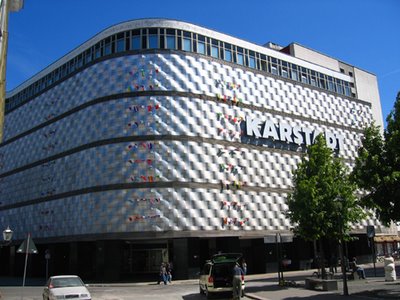
Wagner would be pleased, I’m sure, to know that outside the place where he was born there’s a big rubber contraption; you wrap bungie cords around your children and watch them bounce upon and down on trampolines for a while, and when they come out they’re more docile. If only somebody had done that to him when he was a kid, we all might have been a lot better off!
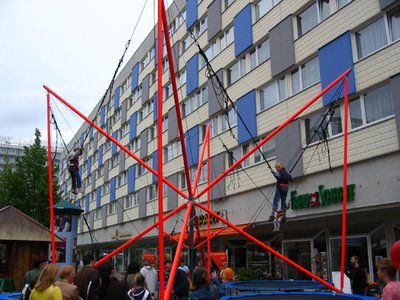
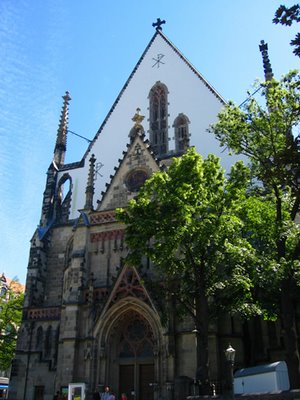
The real tourist draw to Leipzig is not Wagner, but the others: Johann Sebastian Bach in particular, but Schumann and Mendelssohn and others also spent much of their lives here. Bach was cantor for many years at the St. Thomas church, left (and Wagner was expelled from the St. Thomas school behind the church). A particularly great experience was hearing a Bach cantata sung in the church, as part of Bach Fest ’06, by the really wonderful team working there. I could understand most of the sermon, too, which shows you how my German works: talk to me about God and spirit and ghosts and dragons and swords and I’m fine; try to explain to me how to use the laundromat and I’m so hopeless this very sweet girl ended up washing all my clothes for me, while a stood there gawking like an idiot. (The point is: the clothes are clean! That’s what counts.)
As I mentioned, yesterday turned out to be Goth day in Leipzig.
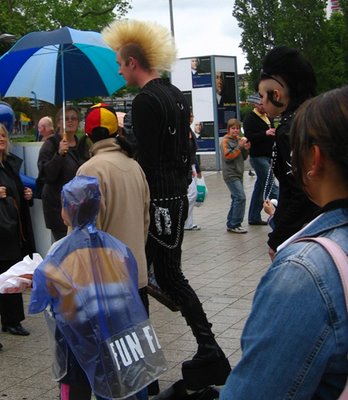
I got more of the story from two university students today, who were very excited that all these Goths were descending upon their city from all over Germany (although neither felt compelled to dress all in black themselves). I remain dubious about the whole enterprise. The fun thing for me, about the Stadt Fest in Leipzig, was passing a booth where this guy in a Hun helmet (that’s a Germanic tribe, not a Viking or Scandinavian tribe—get it right!) served me some mead-beer.
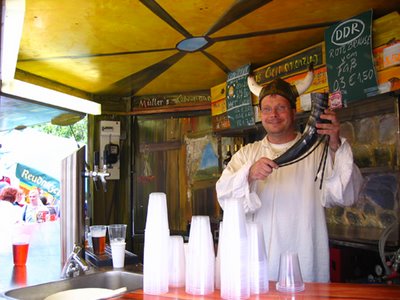
Now, I’ve often had mead-wine (I seem to remember forcing many of you to drink it, much against your will); but this was closer to what the Vikings would have been drinking, basically a very, very sweet beer made entirely from honey. I tell you, travel is all about pushing back boundaries, having new experiences, eating and drinking things you’ve never before dared to try.

Weimar. I blathered here at great length the other day about seeing the Midsummer Night’s Dream here in Weimar; this is a lovely city (much sleepier than Leipzig) with an incredible theater and lots of Goethe stuff. (No Wagner stuff that I’ve found, although he came through here off and on.) Goethe made Weimar the headquarters of the German enlightenment in the late 18th-century, and just as he is (to me) the central writer in the German language, so the town to me typifies what is best about Germany. It’s small, pretty, clean, well-laid out, and has far more than its fair share of culture. In addition the theater, and lots of bookstores, and museums where Goethe and Schiller used to live (Goethe’s house, above, is set up exactly as it was when he died in 1850, and open to the public), and old and new art museums, there’s the Bauhaus museum (yep, they were here) as well as the castle of the Dukes of Saxe-Weimar. Tonight I didn’t feel like I’d be successful following a performance of Schiller’s Maria Stuarda, so I went instead to the little art-house Kino in downtown Weimar—(it was SIFF withdrawal, I’ll admit it)—where they’d never heard of Da Vinci Code or X3. And congratulate me on doing a pretty good job of following the dubbed-into-German Spanish/Argentine old-folks-fall-in-love flick, Fred and Elsa. But while you’re at it, don’t forget the historical role Weimar played as the center of the ill-fated Weimar Republic, back in the 1920s. So even though it’s not technically on the Wagner tour of Germany, I thought it was well worth a stop. And the Goethe-haus was a great way to foreshadow tomorrow’s trip to Villa Wahnfried, Wagner’s house in Bayreuth!
Eisenach. I took a quick day trip out to Eisenach, the small town beneath the hill upon which towers the mighty WARTBURG.

It’s a huge tourist trap, and really not all that exciting; but I had to go, since this is the location of Tannhäuser, one of the few Wagner operas I’ve never titled—and one of his most German operas. (The other is Tannhäuser’s companion-piece, Meistersinger, and we’ll go there next.) The Wartburg’s claim to fame, apart from its scenic location, rests on four points of history: a) St. Elisabeth of Hungary married the Thuringian king and moved here in the high middle ages, where she was associated with all sorts of miracles and did good Catholic saint-type things. b) The famous battle of the minnesingers, a sort of medieval German rap-artist kick-dust-on-the-other-guy’s-pants “I’m a better singer than you” championship was famously held here. c) Martin Luther, fleeing the Catholics, was given sanctuary here and wrote the first ever German translation of the New Testament, thereby starting the Reformation; and d) in the 19th century, Romantics like Wagner got obsessed in old German history and so Wagner wrote his Tannhäuser, hopelessly garbling the already ahistorical legends that had started to spring up about this place. Below, the room from which Martin Luther founded the Protestant church.

I’ve always had a peculiar relationship with Tannhäuser; I wonder what will happen when (if?) I ever get an opportunity to do some titles for it. The overture has been a favorite piece of mine since childhood. But I never particularly cared for the rest of the opera; always thought the music was a tad staid and the story stupid, in fact, until I finally saw it onstage a few years ago at the Met, in the old Schenk/Schneider-Siemssen production from the late ‘70s (their first Met production, and the one that indicated to the Met that this team was good at doing campy Disney-medieval Wagner). My problem had always been disliking the characters and the basic set-up. Tannhäuser, the great medieval German songwriter/singer, needs to choose between two women, and thereby choose between the sacred and the profane, between the classical antiquity of Greece and the medieval Christianity of Germany. When the opera begins, he’s living as the love slave of the goddess Venus, who hangs out with a bunch of fauns and nymphs in a grotto underneath the Hörselberge near Eisenach. The idea is, when Christianity conquered Europe, the old gods—all these mythological characters from ancient Greece—simply went underground, where they continue their revels, and the local Christians fear and hate them. Wagner was fascinated by what happens when new gods replace old gods, and deals with this question in Tannhäuser, Lohengrin, Tristan, and of course the Ring and Parsifal. (If the issue comes up in Meistersinger, it must be in the great hymn to Sachs as Martin Luther.) Anyways, the idea is you’ve got a strictly conservative Christian society above ground (think GWB and his junta) and, below ground, those of us who live on Capitol Hill. I didn’t actually make it into the caves, but here’s a bad shot of the Hörselberge, taken from a moving train:
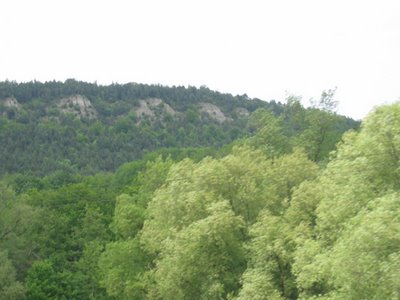
But Tannhäuser is bored of the sensual pleasures of Venus and goes back up to earth, where his old girlfriend the saintly Elisabeth of Hungary is still faithful to him. So faithful that even when it becomes clear to everyone upstairs that he’s been a sinner—that he’s been downstairs, to Venus’s land—Elisabeth loves him so much that she prays herself to death, and he is somehow redeemed.
Now I’ve always thought Venus and Elisabeth were two pretty lame images of women, and I also felt that Tannhäuser (like many another Wagnerian hero, and like Wagner himself) was a bit of an ass. It’s never made any sense to me, to try to separate out your sexual feelings from any other kind of love; and I don’t quite buy the basic world-view of the opera, which seems to be that what Tannhäuser has done is wrong (the way I find what Siegmund and Sieglinde do revolting, no matter how much I’m cheering at the end of the Walküre first act). I find the story, on the surface, a lot of fuss about nothing. When I faced Tannhäuser’s dilemma myself, many years ago, I moved out of the conservative midwest and never looked back.
But when I saw the opera live, for the first time, I noticed that a) I really liked the music, that what was conventional and predictable on the page nevertheless works in the theater and b) for me, the central character was the baritone, Wolfram von Eschenbach, another minnesinger (who in real life wrote the amazing Parzival poem which partially inspired Wagner’s last opera) who is friend to Tannhäuser and in unrequited, unconsummated love for Elisabeth. At the end of the opera, Wolfram stands center stage, with the corpse of the sinner Tannhäuser to his right and the corpse of the saint Elisabeth to his left, and it’s wonderful because he stands for us, neither saints nor terrible sinners most of us, but needing in each of our lives to weave our way between the demands of the body and the demands of the spirit, between good and evil, between desire, self-denial, fulfillment, and satiation, between whatever competing cultures are making claims on our loyalty. And that need makes him write Parzifal.
I’d tell you how all those issues are playing out with me on this trip (including more about the grottoes of Venus I’ve been visiting)...but this isn't that kind of blog! So let me instead show you a few pictures of the Wartburg! Here’s a photo of the castle up close:

Here’s the hall of song, where Act Two theoretically take place (actutally it took place in a less photogenic room downstairs, but the audience won’t know that):

And here’s the view from the ramparts, of the forest through which we pilgrims trod, with weary feet, as we ascended to the glorious heights. Set Act I Scene 2 and Act 3 in here somewhere!

One last thing to add about Thuringia: the beer is great, but I’m never going to be a fan of the bratwurst. On the other hand, it’s pretty easy to find decent Turkish food all over Germany, for very very cheap. And the Turks know from cooking!


1 Comments:
jon--i've had 11 years of higher education and the only people i've heard of in this entire post are wagner and luther. love it!
Post a Comment
<< Home